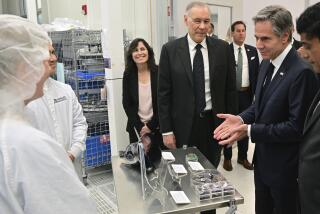Toyota Opens $46-Million R&D; Center in Torrance : Transportation: The auto maker wanted a bigger presence in its crucial California market.
- Share via
Toyota Motor Corp., significantly expanding its presence in Southern California, on Thursday opened a sprawling new $46-million research and development center near its automobile sales headquarters in Torrance.
The technical center, which will share the spotlight today with a greatly expanded Toyota car design facility that is opening in Newport Beach, is part of a $220-million investment to strengthen Toyota’s U.S. research and development capability.
The car maker is joining a host of other Japanese companies that have recently established big research facilities in the United States, including Hitachi Chemical Co.’s $16-million biotechnology lab in Irvine and Shiseido Co.’s $85-million research center at Harvard Medical Center in Boston.
The Torrance center--which was launched in 1975 with a handful of employees operating out of a small garage--will initially employ about 90 people as a result of the expansion. Its primary function will be to conduct laboratory testing of prototype vehicles and evaluate cars on U.S. roads under a variety of weather conditions, officials said.
Automotive research has risen in importance as federal regulators have increased pressure on auto makers to produce safer and more fuel-efficient cars--and as car makers have sought to dazzle consumers with new technology, materials and features.
But Dave Cole, director of the Center for the Study of Automotive Transportation at the University of Michigan, said political pressure on Japanese auto makers is also a key factor behind the recent influx of Japanese research and development centers in the United States.
“As they try to become more and more thought of as American companies, it becomes politically necessary for them to do that,” Cole said. “They can’t just produce here. They have to do their intellectual work here too.”
Toyota decided to build its research facility in Torrance because it wanted a larger presence in the important Southern California car market and because “it is advantageous to be near our (U.S.) suppliers,” said Masaaki Ohashi, senior managing director of Toyota Motor Corp.
Japanese firms in the past have faced criticism from some U.S. scientists and politicians for focusing more on perfecting the research ideas and inventions of others--including American labs and firms--than on costly basic research of their own.
In Torrance, though, Toyota will be importing its ideas from the East. “For the time being, we will take up (ideas) that have been conceptualized in Japan,” Ohashi said through an interpreter.
Because the technical center will be working closely with American auto parts makers, Toyota plans to substantially increase the volume of parts it purchases from U.S. suppliers in the next two years, added Kunihiko Masaki, executive vice president of Toyota Technical Center.
Japanese auto makers have faced mounting pressure to purchase parts from U.S. suppliers as they have come to build more vehicles in the United States. But the Japanese expansion here does not simply represent a bow to American pressure. The auto makers also come in search of skilled technical workers and automotive engineers.
“There’s a shortage of labor in Japan, especially in critical labor skills,” Cole said. “That’s another reason for them to come here.”
Detroit has been the center of much of the auto makers’ intellectual expansion--Nissan and Mazda both have technical centers in that area, and Toyota is rumored to be planning another one. But the devotion with which Southern Californians have purchased their cars helps explain the Japanese auto makers’ attraction to this area, experts say.
“Southern California is considered to be on the leading edge of the automobile industry. That’s why Japanese manufacturers want to be there,” said Wendy Beale Needham, an automobile analyst at Smith Barney, Harris Upham & Co. in New York.
Times staff writer Amy Harmon in Detroit contributed to this story.
More to Read
Inside the business of entertainment
The Wide Shot brings you news, analysis and insights on everything from streaming wars to production — and what it all means for the future.
You may occasionally receive promotional content from the Los Angeles Times.










